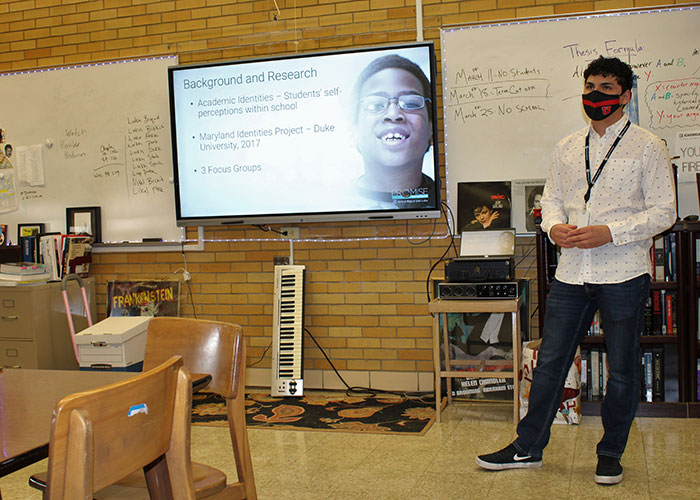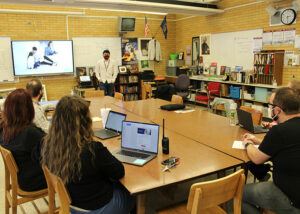The Grassroots Leadership Team at United Way of Salt Lake works to engage community members in conversations about their experiences to create a system where the experiences of those most impacted by issues are guiding the solutions. They do this by first completing community-based research projects to illuminate the stories of those in our communities, then developing actions within the community and institutions to make lasting change. During his fellowship with the Grassroots Leadership team, Esai Castaneda organized a project focused on learning more about how tracking in schools affects Latinx students.

To do this, I connected with students at two schools: Kearns High, which has a tracking system, and Salt Lake Center for Science Education (SLCSE), which is a detracked school. Detracking schools place students with mixed academic achievement in the same introductory classes, with the intention of exposing all students to a high-quality curriculum at the start of high school. Because I had previously worked with Latinx students, and because I am Latinx myself, I wanted to focus my work on the Latinx population.
My research question asked “How do Latinx students perceive their own personal and academic identities compared to other students?” At Kearns, because I wanted to know how students saw themselves in a tracking system and how it impacted them, I focused on comparing the personal and academic identities of students from different tracks.
At both Kearns and SLCSE, the administration helped me connect with Latinx students. At Kearns High school, I connected with the Latinos in Action teacher, Andrew Busath. At SLCSE, the principal connected me with an administrator, Alondra Moreno-Saucedo. Both of these contacts introduced me to students who fit the criteria for participation in my focus groups.

My focus groups at Kearns High school were determined by their tracks: six students participated in a core focus group; five students participated in an honors focus group; one student participated in an AP/CE interview. I had two focus groups at SLCSE consisting of six and five students, respectively. At each school, separate findings arose.
It is difficult to make direct comparisons between the tracked and detracked schools because of differences in enrollment size and type of school (public and charter). However, I was able to identify themes for both schools which highlighted the students’ experiences at each school.
At Kearns High, student responses varied by track. For example, when I asked students in core classes about their strengths and weaknesses, they identified social skills as their greatest strength and put a lot of emphasis on their weaknesses. They also had a difficult time identifying their strengths in school. On the other hand, the AP-track student I interviewed said they felt that they did not have a life outside of school. Finally, the students in the honors courses identified their strengths as being hardworking and helping other students.
My focus groups and interviews at Kearns also showed me how students are impacted by the perceptions of other students. Students in core felt that AP students saw them in a negative light because they were not in AP classes; they identified negative experiences with AP students related to these perceptions. Students in all tracks said that the difference between the tracks was pace and that they were all capable of learning all the material. Students in core highlighted that, although they said that they took longer to learn subjects, they believed they were just as smart as other students. Based on these findings, I believe that tracking did have significant impacts on students at Kearns High and it is worth discussing what tracking is accomplishing, especially considering the impacts it has on students.
The main themes that arose at Kearns were:
- Students wanted to be valued by their growth and not their grades.
- Students benefitted from having strong support from staff and teachers.
- Students found negative interactions more significant than positive ones.
- Students wanted one-on-one time with teachers and other students to fully understand the subject.
- The purpose of tracking was unclear and students couldn’t precisely identify the differences between honors and core.
The focus groups at SLCSE also delivered interesting results. Most students were able to recognize their identities within the school and outside of school. Students did not identify strong negative perceptions amongst each other. The few negative perceptions that were identified were tied to racism, not education.
The main themes from the focus groups at SLCSE were:
- Students felt that they carried the responsibility of their education.
- Students wanted to be recognized for their whole identity and situation beyond school. This included recognizing their racial identity and socioeconomic status.
- Students were satisfied with their education but felt that not all courses reflected their goals and interests.
- Students felt that community building was more difficult within their school because they didn’t have many opportunities to come together as a whole student body. They attributed this to the size of their school and to the limited number of clubs.

Students in my project shared their experiences from school, what worked best, and what can be improved on. During my own time as a high school student, I was never asked about my experiences or ideas at the K-12 level. Students are almost never asked about their own education, nor are their experiences given enough value within the education system. I believe that projects like mine can help schools and organizations better connect with students to understand their experiences. Including student voices will help them feel more in control of their education and encourage more participation. Students want to talk about their experiences and want to improve the education system; encouraging them to voice their opinions will allow administrations to identify issues and create relevant action plans rather than searching for solutions in the dark.
By Esai Castaneda, Grassroots Fellow with United Way of Salt Lake

